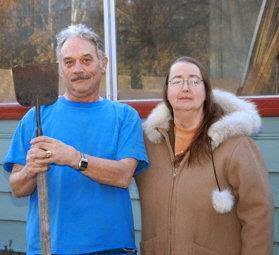I asked Tara to answer the following questions for us:
1. How did you come to learn you have TOS?
2. What treatments have you tried?
3. What is helpful to you now in living with TOS?
I just had to put this part of Tara’s response here at the beginning-it is so important I wanted you to catch it right away…
“Try to avoid toxic people and encounters whenever possible and learn who your real friends are. You will need them. Our lives may feel diminished, but learn what you still have and embrace it.”
~ ~ ~
 “It appears I was born with all the elements that
predisposed me to developing Thoracic Outlet Syndrome.
“It appears I was born with all the elements that
predisposed me to developing Thoracic Outlet Syndrome.I have two cervical ribs as well as elongated C-7 transverse processes on both sides. The only indicators I had growing up were heaviness and loss of strength in my arms when doing overhead activities like swimming or arranging my hair or fussing with my blankets in bed.
Ironically, I was exceptionally strong, easily doing necessary things like chopping wood and hauling water from the spring near our wilderness home. I don't recall suffering any ill effects from those "arms down" activities. Straight and strong, I didn't notice my posture changing until I was about sixty years old. By then I had gone from slim and buxom to plump and heavy bosomed. My body had gradually curled forward from the extra weight.
Everything came crashing in when I was working with a rather large three-year-old boy, who had to be contained over an eight hour shift. He jerked and pulled and twisted my arms the entire day, while trying to escape--wanting to harm other youngsters in the room. At the end of the day, my arms felt as if they were dislocated--weak and painful. Sleep became nearly impossible, because almost any position I lay in, my hands would lose circulation and start throbbing. I reported the injury to my supervisor.
I was diagnosed with a shoulder impingement and sent to physical therapy. Unfortunately, the type of therapy I was given was the worst type to be used for TOS. My work-outs included exercises with weights, therabands, and an arm bicycle. While the impingement improved, a deeper pain began to develop, sending shooting pains down my arms along with burning, tingling, and numbness into my hands.
When the sports medicine specialist I was seeing declared himself stumped, I told him about an EMG I'd had a few years earlier which had shown nerve irritability. The neurologist had told me about "Droopy Shoulder Syndrome" and said I had the body type for it. Looking up the term on Google, I'd learned of TOS.
My specialist snapped his fingers and said, "That's it!" He ordered a new EMG, and an MRA, then referred me to a local surgeon whose wife has TOS. The tests showed compressed veins, and True Neurogenic TOS was diagnosed. I was rushed into surgery.
Unfortunately, the surgeon I was referred to has a history of being very experimental. The first doctor I saw was very kind and seemed to possess good surgical skills. But his senior partner, who stood in to help, decided to try a different surgical method. The records were falsified to say the surgery had been done as I was told it would. A year later I was back for a second surgery on the left, as I had gone bi-lateral. The second surgery was disastrous! From all appearances the senior partner left early and turned me over to his students. Falsified records said, "complete rib removal and scalenectomy".
Nothing resolved correctly and it took two more years to find and be treated by a TOS specialist, Dr. Dean Donahue at Massachusetts General Hospital in Boston. Dr. Donahue's special contrast CT scan, imaged my cervical ribs and the terrible surgical techniques used on me previously.
Since our first meeting in 2010, Dr. Donahue has performed clean-up surgery on both sides and identified the combination of issues involved. I have "true neurogenic TOS" with classic Gilliatt-Sumner Hand--nerve damage and wasting muscle at the thumb base. The elongated C-7 transverse processes sent fibrous bands into the scalene triangles, where adhesions clamped them to the scalenus minimus (small, extra scalenes )-trapping the arteries between them.
 With just chunks of both first ribs
removed, the prior incomplete surgeries left the periosteum/bone casing's cut
ends drifting. Those casings caused a healing response from my body and new
bone regenerated in them-like it would from a fracture. The anterior scalenes
had also been cut and left drifting until they met and attached to those loose
bone casings. From that response, a sling formed across my brachial plexus on
each side and then adhered to each pleura, creating new compression. The repair
surgeries were lengthy and difficult--the one on the left was not enough to
reverse all the nerve damage.
With just chunks of both first ribs
removed, the prior incomplete surgeries left the periosteum/bone casing's cut
ends drifting. Those casings caused a healing response from my body and new
bone regenerated in them-like it would from a fracture. The anterior scalenes
had also been cut and left drifting until they met and attached to those loose
bone casings. From that response, a sling formed across my brachial plexus on
each side and then adhered to each pleura, creating new compression. The repair
surgeries were lengthy and difficult--the one on the left was not enough to
reverse all the nerve damage. The right side was especially bad, with the brachial plexus wrapped twice in thick slabs of scar tissue. Despite the surgery taking 4 1/2 hours, the damage has been significantly reversed and strength is returning to the hand.
Workman's comp has dogged my every step, with adjusters stalling my medications and procedures. In spite of that, I have tried PT, lidocaine injections, Botox, radio-frequency ablations, intermuscle stimulation (IMS), aka dry needling and numerous medications. The two most beneficial treatments have come from my manual physical therapist. He has pioneered some gentle stretching methods that are especially easy on TOS patients. He also learned manual lymph drainage (MLD) and dry needling therapy (IMS) which when used in conjunction work miracles on my trapped lymph build-up.
Living with TOS is especially discouraging, knowing it is for life and will not be cured. We need to develop arsenals of pain-relief methods--each will be as individualized as the people developing them. Many pharmaceutical medications have been tried, but nothing has proven especially useful to me. Things like Cymbalta and Lyrica are caustic to my gut and I have had to eliminate them from the list. At present, I use Wellbutrin and flexeril in conjunction with curcumin/turmeric and several vitamins and supplements. They seem to take the edge off daily pain. Soma helps when I can't sleep.
Distractions are very important and I use them frequently. Books, movies and music all help me to switch focus from pain. Travel in general is pleasant, but my very favorite is road-tripping! My tens unit and infra-red lamp are soothing, frequent companions at home and on the road.
I try not to dwell on my afflictions or tell my lengthy tale to everyone I meet. Just accepting that we have TOS can help us move forward.
Getting the best medical help you can afford is primary, but you may have to hire and fire several doctors before you find someone truly helpful. A TOS specialist can be beneficial if s/he has more in his/her lexicon than surgery. Pain specialists can also help, if you are willing to be experimental. You may find that your best and most consistent help comes from your trusted GP.
Devise coping methods that help get you through and learn what you can do to normalize your situation as much as possible.
Learn to respect your new limits and ask for help.”
~ ~ ~
Thanks for sharing with us Tara.